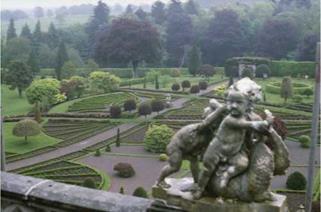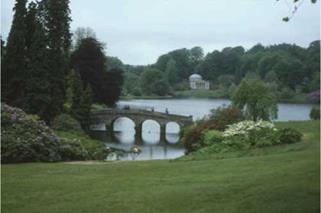|
![]()
![]()
![]()
 OBJECTIVES
OBJECTIVES
Upon completion of this chapter, you should be able to
• list three influences on contemporary landscape design.
• define the objectives of contemporary landscaping.
• describe the outdoor room concept.
• select plants to fill a role in the landscape.
• select enrichment items and construction materials for the landscape.
• recognize graphic tools and techniques used to illustrate a landscape plan.
• create a residential landscape plan that incorporates the principles of design.
KEY TERMS
mylar
drafting cloth perspective
THE NEED FOR GARDENS
Gardens are the pleasure grounds of civilization. They date back to the ancient Egyptians, Greeks, and Romans, and perhaps earlier. Historically, gardens have been as much an expression of their owners’ social status and political power as they have been places for recreation. Nobility throughout Europe, Asia, and Africa built gardens on a grand scale, often measured in square miles, as a way of exhibiting their domination over a hostile natural world. In other times and places, gardens were developed as tribute to religious figures: Monastic gardens honored Christian martyrs throughout Europe; and Far Eastern cultures built gardens to their deities.
Through much of history, gardens have belonged to the privileged, not the common person. Today, however, gardens grow in the middle – class suburbs, city centers, and on farms. They fill public plazas, shopping malls, and parks. The American approach to landscaping is giving new direction to an old profession.
Three major influences have shaped American attitudes toward landscaping:
1. the formal tradition of 16th – and 17th-century Europe
2. the naturalism of 18th-century England
3. the nature symbolism of the Orient
The 16th-century Italian Renaissance gardens and the 17th-century French baroque gardens exemplify the formal tradition in landscape design (Figure 9-1). They are characterized by symmetrical layout patterns, severe shearing of plants (topiary pruning, described in Chapter 12), the use of ornate fountains and sculpture, and an overall architectural quality. The gardens left no doubt about the importance of the owners and their ability to dominate the natural world.
England, in the 18th century, found its royal court life less formal than that of continental Europe. Also the general attitude of the people toward the natural world was less fearful and more conciliatory. As a result, the formal garden fell from fashion and a more natural appearance became popular (Figure 9-2). Natural was defined by the landscape designers, however, and the style called naturalism required planning as meticulous as that of the most formal gardens. The designers of these English Naturalism gardens tore out the formal, symmetrical gardens with zeal and replaced them with lakes and islands, rolling hills, pastoral lawns, grazing animals, and added such picturesque touches as manufactured “ruins,” dead trees, hermits’ cottages, and vistas toward distant temples. Grass was brought right up to the walls of the stately homes, a departure from the embroidery-like flower beds that surrounded them in formal gardens. Straight lines were practically nonexistent, in the belief that nature’s lines are always curvilinear.
Naturalism not only reshaped the landscape of England but reached across the Atlantic to influence the public park movement in the


figure 9-1. A garden in the Italian Renaissance style (Delmar/Cengage Learning)
figure 9-2. Romanticized landscapes typified eighteenth century English gardens. Carefully composed natural scenes were intended to evoke pleasurable emotions. (Delmar/Cengage Learning)
|
|
figure 9-3. There is a strong Japanese influence in the use of stone and water for this garden. (Delmar/ Cengage Learning)
United States. When Frederick Law Olmstead, the dean of American landscape architects, joined Calvert Vaux in the planning the New York City’s Central Park, the design concepts of naturalism found new form. Central Park was the first important urban garden created for the pleasure of ordinary people. It was, and still remains, the flagship of the American landscape movement. It is a movement that now sets the pace for much that is done worldwide.
The other major influence on America’s landscape style came from the Orient, principally from China and Japan. For centuries, Eastern and Western cultures were isolated from each other and developed distinctly different garden styles. Even today, full appreciation of a genuine oriental garden is beyond the comprehension of most Europeans and Americans, who are unfamiliar with the religious and spiritual beliefs of the orient. The style of these gardens is based on miniaturization of the natural world. Within a small garden area, carefully screened from the world outside, mountains, rivers, islands, clouds, animals, and forests may all be found. Components of the natural world are symbolized with materials including sand and stones, special pruning techniques, and clever land forms. Animal forms may be shaped with stones; rivers and pools may be represented by raked sand; ripples may be fixed in time as concentric rings in a pool of sand; mountains may be rolling mounds of soil; and clouds may be tufted shrubs.
Unlike Western gardens, usually planned for recreation and entertainment, Eastern gardens are planned for contemplation and meditation. Their influence on American gardens can be seen in the use of space and form, in pruned yet naturally shaped trees and shrubs, in stone as a sculptural form, and in certain furnishings (Figure 9-3).




